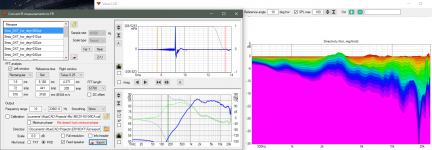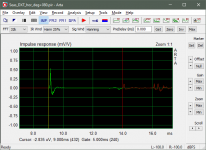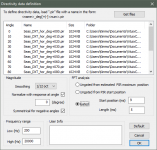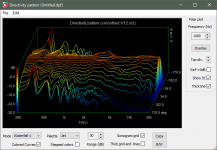Hi hensolo and thanks for your suggestion.
Does the computer detect noise from the mic preamp power supply?
the preamp can also be powered by batteries, I have never used it, maybe the time has come to use them.
Does the computer detect noise from the mic preamp power supply?
the preamp can also be powered by batteries, I have never used it, maybe the time has come to use them.
Give it a try. My laptop's power supply is exactly catching the interference of the power grid. I got rid of them by disabling the grounding contact in the fork. I can't explain why it worked.
...by disabling the grounding contact in the fork.
Don't do this. The ground pin is for your safety. It saves lives (yours, your family members, friends, and others). If you need to get rid of mains power noise, disconnect the laptop from mains power and run it using the battery.
What do you think, if the level of one signal is 20 dB lower than the level of the other signal, the listener will hear both signals, or only one? The second question is if the level of the weak signal is lower by the level of the strong signal by 30 dB or more.
Last edited:
I have heard 'harsh treble' caused by a mid cone breakup at 20dB below the tweeter level, maybe it could be heard at 30dB too.
absolutely.
for Orion we had a notch for breaking w22EX to over 48db below the signal.
the circuit has received a lot of attention through modifications and perhaps it has never been completely solved since S.L. when he listened to Pluto,
it seems to me that it was Pluto,
he marveled because the midrange was better.
for Orion we had a notch for breaking w22EX to over 48db below the signal.
the circuit has received a lot of attention through modifications and perhaps it has never been completely solved since S.L. when he listened to Pluto,
it seems to me that it was Pluto,
he marveled because the midrange was better.
I was talking about a sound-rich signal, along with which there are quiet signals 20 dB quieter than the main signal. For example, an orchestra plays, groups of 5-10 instruments, and simultaneously a violin or trumpet is playing 20 dB quieter. Will this violin or trumpet be heard? If it is 30 or 40 dB quieter?
If the trumpet is present it is because it contributes to the sound, then you will hear its contribution.
The hard part is to say how distinctly you can feel.
many variables are at stake.
Has the microphone captured every tiny nuance?
Does your system have a resolution to show tiny nuances?
In this latter case your acoustics become very important.
the errors generated by the acoustics are the main ones responsible for the quality of listening.
Occasionally listening even with a good headphone can help to judge the resolution of your audio equipment by excluding the distortions introduced by your environment.
The hard part is to say how distinctly you can feel.
many variables are at stake.
Has the microphone captured every tiny nuance?
Does your system have a resolution to show tiny nuances?
In this latter case your acoustics become very important.
the errors generated by the acoustics are the main ones responsible for the quality of listening.
Occasionally listening even with a good headphone can help to judge the resolution of your audio equipment by excluding the distortions introduced by your environment.
Valtergio,
The last question is related to the display of the influence of weak sounds in the crossover simulator program. It reacts correctly to all crossover changes, but sometimes I don't understand her. Sometimes a change in the frequency response graph, which is 50 dB lower than the main signal level, causes a change in the resulting (all speakers with a crossover) frequency response. And then I start to think that the program is not working properly.
The last question is related to the display of the influence of weak sounds in the crossover simulator program. It reacts correctly to all crossover changes, but sometimes I don't understand her. Sometimes a change in the frequency response graph, which is 50 dB lower than the main signal level, causes a change in the resulting (all speakers with a crossover) frequency response. And then I start to think that the program is not working properly.
Please I couldn't find in such a long thread... I'm interested is there an option in free version of Arta for measuring thd vs outut voltage, thd vs frequency?
hensolo,
if I understand correctly, are you using a crossover through your computer?
so do you have a program that manages the crossover?
I use all analog components and I have no experience of crossover programs through the computer, however I work with computers and
I can give you some good advice on how to best manage your computer and avoid malfunctions.
All programs have more or less important bugs that are usually improved or fixed with patches and then there is the behavior of the computer with the S.O.
If you want to stay away from problems and get stable behavior, you have to meet some rules.
The operating system must not be corrupted, and it is not easy to understand when it is.
you may have some small malfunction caused by corruption of system files or conflicts caused by files of other programs and it is not easy to trace the cause, it is better to restore the computer from scratch.
If I can give you some advice, I would reinstall the computer from scratch, then update all the drivers, and first install the crossover program.
If the problem recurs, you should contact the crossover software manufacturer.
If, on the other hand, the problem does not recur, I would wait a reasonably long time to be sure, after which you install one by one the programs that you had before on the computer.
To do things right you should install one program at a time and repeat the test time, if all goes well move on to the next program.
This method would allow you to understand which program is causing the malfunction.
If the computer was mine, it would be a computer dedicated only to the crossover program and the bare essentials that I need.
Each program requires a minimum HW, from experience it is better that your HW is much higher than the minimum required.
if I understand correctly, are you using a crossover through your computer?
so do you have a program that manages the crossover?
I use all analog components and I have no experience of crossover programs through the computer, however I work with computers and
I can give you some good advice on how to best manage your computer and avoid malfunctions.
All programs have more or less important bugs that are usually improved or fixed with patches and then there is the behavior of the computer with the S.O.
If you want to stay away from problems and get stable behavior, you have to meet some rules.
The operating system must not be corrupted, and it is not easy to understand when it is.
you may have some small malfunction caused by corruption of system files or conflicts caused by files of other programs and it is not easy to trace the cause, it is better to restore the computer from scratch.
If I can give you some advice, I would reinstall the computer from scratch, then update all the drivers, and first install the crossover program.
If the problem recurs, you should contact the crossover software manufacturer.
If, on the other hand, the problem does not recur, I would wait a reasonably long time to be sure, after which you install one by one the programs that you had before on the computer.
To do things right you should install one program at a time and repeat the test time, if all goes well move on to the next program.
This method would allow you to understand which program is causing the malfunction.
If the computer was mine, it would be a computer dedicated only to the crossover program and the bare essentials that I need.
Each program requires a minimum HW, from experience it is better that your HW is much higher than the minimum required.
Valtergio, thanks. I'm fine with the computer. I am designing a crossover for acoustics using VituixCad. It was about the work of VituixCad. I do not control the crossover on the computer. The crossover, like yours, is analog.
New feature request to Ivo
Hi Ivo,
Just wondering if it might be possible to add the following:
1.ability to show a legend on the graphs as an option for all of the software
2. the ability to show different colors for mulitple overlay/target curves in LIMP to more closely evaluate the different T/S models
3. Larger FFT option in LIMP?
Thanks,
Jay
Hi Ivo,
Just wondering if it might be possible to add the following:
1.ability to show a legend on the graphs as an option for all of the software
2. the ability to show different colors for mulitple overlay/target curves in LIMP to more closely evaluate the different T/S models
3. Larger FFT option in LIMP?
Thanks,
Jay
Arta help please
Please forgive me if these question have been asked before.
1. Is is possible to normalise a FR, set it as an overlay, load another IMP and add the normalisaton 'error' to that response in FR?
I'm trying to make a polar response plot that shows just the off-axis errors.
2. I find the FFT analysis option of the Directivity Data Definition box confusing. How do I set the gated time window for each response? Where can I find the appropriate 'Start position' value?
with many thanks,
Please forgive me if these question have been asked before.
1. Is is possible to normalise a FR, set it as an overlay, load another IMP and add the normalisaton 'error' to that response in FR?
I'm trying to make a polar response plot that shows just the off-axis errors.
2. I find the FFT analysis option of the Directivity Data Definition box confusing. How do I set the gated time window for each response? Where can I find the appropriate 'Start position' value?
with many thanks,
Thanks for this. I'm having trouble locating the 'Convert IR to FR' window option. Maybe it's like the spanner you want being invisible in front of you...
can you point me to it?
can you point me to it?
Use "Tools" folder and the dropdown menu, the Convert IR to FR is there.....or use F9 shortkey
Anyway, directivity plot should work directly with ARTA. Just open pir file e.g. 80 deg to IR window and investigate start position and length of time window. Set those values to directivity pattern tool and plot.



